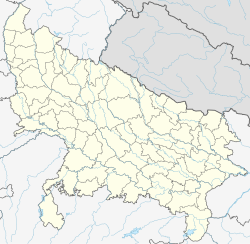Shahpur, Lalganj
In this article we are going to delve into the fascinating world of Shahpur, Lalganj. From its origins to its relevance today, Shahpur, Lalganj has been a topic of interest in various fields. Throughout history, Shahpur, Lalganj has demonstrated its influence in society, culture, technology, politics, and many other areas. Through in-depth analysis, we will explore the different perspectives and approaches that have emerged around Shahpur, Lalganj, as well as its impact on everyday life. This article seeks to give a comprehensive view of Shahpur, Lalganj, providing relevant and updated information for those interested in expanding their knowledge on this topic.
Shahpur
Shāhpur | |
|---|---|
Village | |
 Map showing Shahpur (#803) in Lalganj CD block | |
| Coordinates: 26°10′10″N 80°55′25″E / 26.169386°N 80.923691°E[1] | |
| Country | |
| State | Uttar Pradesh |
| District | Raebareli |
| Area | |
• Total | 1.418 km2 (0.547 sq mi) |
| Population (2011)[2] | |
• Total | 689 |
| • Density | 490/km2 (1,300/sq mi) |
| Languages | |
| • Official | Hindi |
| Time zone | UTC+5:30 (IST) |
| Vehicle registration | UP-33 |
Shahpur is a village in Lalganj block of Rae Bareli district, Uttar Pradesh, India.[2] It is located 8 km from Lalganj, the block and tehsil headquarters.[3] As of 2011, it has a population of 689 people, in 126 households.[2] It has 1 primary school and no healthcare facilities, and it hosts both a permanent market and a weekly haat.[2] It belongs to the nyaya panchayat of Behta Kalan.[4]
The 1951 census recorded Shahpur as comprising 4 hamlets, with a total population of 260 people (149 male and 111 female), in 58 households and 44 physical houses.[5] The area of the village was given as 340 acres.[5] 45 residents were literate, 41 male and 5 female.[5] The village was listed as belonging to the pargana of Sareni and the thana of Sareni.[5]
The 1961 census recorded Shahpur as comprising 1 hamlet, with a total population of 324 people (168 male and 156 female), in 65 households and 54 physical houses.[6] The area of the village was given as 340 acres and it had a medical practitioner at that point.[6]
The 1981 census recorded Shahpur as having a population of 449 people, in 83 households, and having an area of 141.64 hectares.[3] The main staple foods were listed as wheat and rice.[3]
The 1991 census recorded Shahpur as having a total population of 482 people (258 male and 224 female), in 62 households and 62 physical houses.[4] The area of the village was listed as 142 hectares.[4] Members of the 0-6 age group numbered 73, or 15% of the total; this group was 58% male (42) and 42% female (31).[4] Members of scheduled castes made up 11% of the village's population, while no members of scheduled tribes were recorded.[4] The literacy rate of the village was 39% (130 men and 59 women).[4] 183 people were classified as main workers (155 men and 28 women), while 0 people were classified as marginal workers; the remaining 299 residents were non-workers.[4] The breakdown of main workers by employment category was as follows: 111 cultivators (i.e. people who owned or leased their own land); 56 agricultural labourers (i.e. people who worked someone else's land in return for payment); 0 workers in livestock, forestry, fishing, hunting, plantations, orchards, etc.; 0 in mining and quarrying; 10 household industry workers; 4 workers employed in other manufacturing, processing, service, and repair roles; 0 construction workers; 4 employed in trade and commerce; 0 employed in transport, storage, and communications; and 28 in other services.[4]
References
- ^ "GeoNames Search". geonames.nga.mil. Archived from the original on 12 April 2014. Retrieved 21 June 2023.
- ^ a b c d e "Census of India 2011: Uttar Pradesh District Census Handbook - Rae Bareli, Part A (Village and Town Directory)" (PDF). Census 2011 India. pp. 288–306. Retrieved 21 October 2021.
- ^ a b c Census 1981 Uttar Pradesh: District Census Handbook Part XIII-A: Village & Town Directory, District Rae Bareli (PDF). 1982. pp. 152–3. Retrieved 21 October 2021.
- ^ a b c d e f g h Census 1991 Series-25 Uttar Pradesh Part-XII B Village & Townwise Primary Census Abstract District Census Handbook District Raebareli (PDF). 1992. pp. xxiv–xxviii, 186–7. Retrieved 21 October 2021.
- ^ a b c d Census of India, 1951: District Census Handbook Uttar Pradesh (42 - Rae Bareli District) (PDF). Allahabad. 1955. pp. 118–9. Retrieved 21 October 2021.
{{cite book}}: CS1 maint: location missing publisher (link) - ^ a b Census 1961: District Census Handbook, Uttar Pradesh (39 - Raebareli District) (PDF). Lucknow. 1965. pp. lxxvi-lxxvii of section "Dalmau Tahsil". Retrieved 21 October 2021.
{{cite book}}: CS1 maint: location missing publisher (link)
